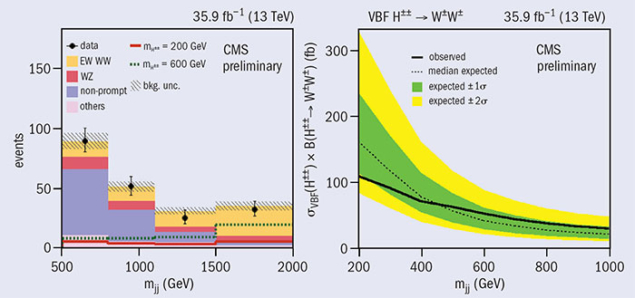
The LHC was built with a guaranteed discovery: the ATLAS and CMS experiments would either find a Higgs boson, or it would discover new physics in vector boson scattering (VBS) at high energies. The discovery of a Higgs-like boson in July 2012 confirmed that the W and Z bosons acquire mass through the Higgs mechanism, but to determine whether the observed particle corresponds to the single Higgs boson expected in the Standard Model (SM), it is now paramount to precisely measure the Higgs boson’s contributions to VBS. Since the behaviour of VBS amplitudes is sensitive to the way Higgs and vector bosons couple to one another and to the Higgs boson’s mass, models of physics beyond the SM predict enhancements to VBS via modifications to the Higgs sector or from the presence of additional resonances.
A recent analysis by CMS aimed to identify events in which a W-boson pair is produced purely via the electroweak interaction. Requiring events to have a same-sign W-boson pair reduces the probability of production via the strong interaction, making it an ideal signature for VBS studies. The first experimental results on this final state were reported by ATLAS and CMS based on 20 fb–1 of LHC data collected in 2012 at an energy of 8 TeV, but were insufficient to claim an observation. The new study is based on 36 fb–1 of data collected in 2016 at 13 TeV. Events were selected by requiring they contain two leptons (electrons or muons) with the same electric charge, moderate missing transverse momentum, and two jets with a large rapidity separation and a large dijet mass. About 67 signal events were expected, with the dominant sources of background events coming from top quark–antiquark pairs and WZ boson pairs. The event yield of the signal process is then extracted using a 2D fit of the dijet and dilepton mass distributions (figure, left).
The new CMS study provides the first observation of the electroweak production of same-sign W-boson pairs in proton–proton collisions, with an observed significance of 5.5 standard deviations. The result does not point to physics beyond the SM: a cross-section of 3.8±0.7 fb is measured within the defined fiducial signal region, corresponding to 90±22% of the result expected. An excess of events could have been caused by the presence of a doubly charged Higgs boson that couples to W bosons, and the analysis sets upper bounds on the product of the cross-section and branching fraction for such particles (figure, right). Bounds on the structure of quartic vector-boson interactions are also obtained in the framework of dimension-eight effective field theory operators, and the measurements set 95% confidence-level limits that are up to six times more stringent than previous results.
This first observation of the purely electroweak production of same-sign W-boson pairs is an important milestone towards precision tests of VBS at the LHC, and there is much more to be learned from the rapidly growing data sets. Studies demonstrate that the High Luminosity LHC, due to enter operation in the early 2020s, should even allow a direct investigation of longitudinal W-boson scattering.








